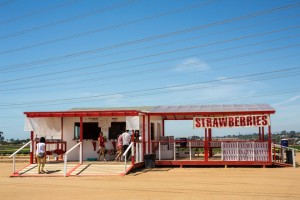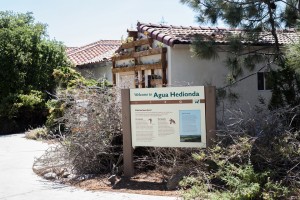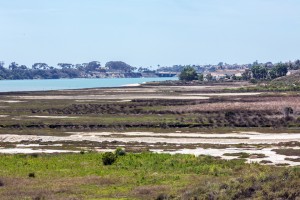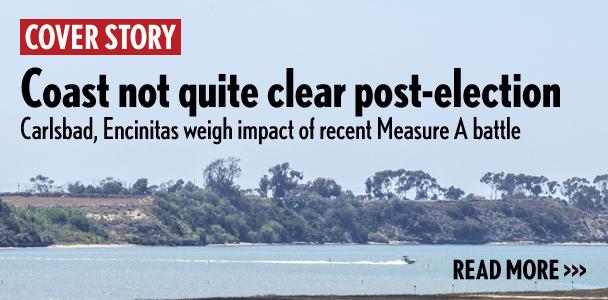Coast not quite clear post-election
Carlsbad, Encinitas weigh impact of Measure A battle
Carlsbad’s Agua Hedionda Lagoon, pictured April 20, attracts recreational users from around the region. (Photo by Jen Acosta)
April 29, 2016
Measure A — the special election in Carlsbad to vote on the development of a mall at the Agua Hedionda Lagoon — was defeated at the polls earlier this year, but the idea of development at the site remains a subject of controversy and inspiration in North County.

Cori Schumacher — a local surfer, environmental activist and candidate for Carlsbad City Council in this year’s election — said she believes that Agua Hedionda Lagoon is both the “geographical and symbolic heart of when Carlsbad took back its power.” Schumacher originally became involved with “No on A” after attending and speaking at a meeting of the Carlsbad City Council in August 2015, where the council voted to not allow the public to vote on whether to let Los Angeles-based developer Caruso Affiliated build a mall at the lagoon site.
Had Measure A been passed Feb. 23, the mall would have been built on 21.6 out of 48.3 acres that had previously been zoned for visitor-serving commercial use, and the 155.10 acres that was set aside as open space through the 2006 Proposition D vote would have been increased to 176.7 acres of open space, according to the Carlsbad city website. The measure would have preserved longtime strawberry fields at the site, as well.

“The council unanimously voted to disallow Carlsbad residents from voting on the project,” Schumacher said. “At that meeting, I realized what an overreach of government that was; I completely disagreed with the City Council’s decision and decided from that moment to become active with the referendum to get Carlsbad to vote on that project.”
Though she hadn’t given thought to becoming a politician previous to her involvement on the “No on A” campaign, the process inspired her to run in this year’s election. Schumacher said that witnessing the community come together against Measure A was a major inspiration for her to run for City Council.
“To see that unity and coming together and defeating not only the City Council, but defeating that $11 million worth of influence here in Carlsbad, I came to the realization that the political process does work when you’re engaged with a group of people who are passionate and that it was important to carry this spirit forward,” Schumacher said.
Debating fact vs. fiction

Carlsbad City Councilman Michael Schumacher — a supporter of Measure A — said that he believes that the information from both the proponents and opponents was conflicting and at times inaccurate, leading to the measure being voted down.
“It was challenging, it was a complicated project and challenging for people to really understand and separate fact from fiction,” Councilman Schumacher said. “The proponents put out information, and the opponents — the No on A people — put out information and then there was a third source — which was the city’s information that they put out — which was very factual-based: here’s what’s the land is zoned, for example, here’s how many acres it is, here’s what’s the allowable uses.”
The councilman, who is not related to Cori Schumacher, said he supported Measure A because he felt it guaranteed a set amount of open space and that the space would be dedicated to trails and outdoor recreation, as opposed to the Proposition D alternative of that space potentially being used for museums and parking lots.
“(Prop. D) planned out what was the allowable uses on that space; if you go to the city’s website and look at Prop. D’s and what it’s allowable use is, you’ll find it’s aquariums, it’s museums, it’s retail and restaurants — and all the parking, and all the concrete and all the asphalt that goes along with that — those are actually allowed on the 155 acres, per Prop. D, on the open space land,” Councilman Schumacher said. “I don’t think of museums and supporting retail as open space, I think of trails and views and that sort of thing.”
Setting a precedent
De’Ann Weimer — president of Citizens for North County and one of the three co-founding members of the No on Measure A campaign — said that concern was originally raised about Caruso Affiliated building a mall at the Agua Hedionda Lagoon last spring. Upon the original proposal of the mall, members of the community wanted input on the development, and wanted the Proposition D 2006 decision to preserve 155.10 acres of land to be upheld.

“We couldn’t get any specifics, so we were disturbed by the fact that they would then come about with the initiative on a piece of property that had already been addressed by the city in the Prop. D initiative,” Weimer said. “Going around the process and subverting what was intended for that piece of property that had already been voted on by the people is what got me involved.”
Weimer said she thinks that the outcome of the special election will send a message to other developers that North County residents are passionate about their open spaces.
“I think it sets a precedent because it shows developers that citizens in North County care passionately about their open space and they will defend it and expand it as much as they possibly can, and I think that it would be kind of a chilling effect on future developers to come forward with anything like what Caruso Affiliated spent more than $10 million on,” Weimer said. “Some of the stipulations of Prop. D are still sitting before the Coastal Commission and haven’t been acted on after all this period of time, because it hasn’t been a priority with the city.”
Some people who supported the No on A campaign — such as Weimer and Cori Schumacher — are hoping that the momentum from the election will be a call for action to create the trails that the community has wanted.
“For that particular parcel, there are many people who have become extremely interested in activating the hub lease that’s currently on that property — has been since the 1970s — for, specifically, trails,” Cori Schumacher said. “So there’s quite a large number of us who are really strongly asking the City Council to put trails there, something that our entire community can use regardless of whether you are opposed or Measure A … I think that beyond that, the city of Carlsbad has awakened to a different way of moving forward politically — with the special election, it was the biggest voter turnout in San Diego County history, and there is really no going back from that.”
Impact felt in Encinitas?

While Encinitas City Councilwoman Catherine Blakespear said she feels that Encinitas differs from Carlsbad in that it already has a long history of the community being involved in the city’s legislative development, she said that this will likely impact the area in that future projects won’t be able to attempt to easily circumvent CEQA (California Environmental Quality Act) guidelines, as Caruso Affiliated attempted to do at Agua Hedionda Lagoon.
“The issue of whether they follow the proper process I think underlies a lot of the outrage about the City Council approving it,” Blakespear said. “It calls into question the role of an elected official — the Carlsbad City Council, were they basically just exercising their discretion in the way that they thought was best for the residents of Carlsbad and the way that this the project, that Caruso, approached it?”
Blakespear likened the case of the Agua Hedionda Lagoon development to the issue of developing the Coastal Rail Trail in Encinitas. The area surrounding the train tracks through Encinitas is currently undeveloped and fenceless, but if proponents of developing it had had their way, a bike trail and fence would have been built alongside it — blocking access across the tracks to the coast, Blakespear said via email.
Instead, part of a 44-mile bike trail from San Diego to Oceanside will be built alongside Coast Highway 101, from Chesterfield to Swami’s. The Encinitas City Council voted 4-1 on March 30 in support of this alternative plan, which will leave the original rail trail path in its natural state for the time being, and to set up a working group to discuss the design of the bike trail along Coast Highway 101.
Blakespear said that she feels the key to governing a community is to make sure they are actively involved with large decisions — such as the Agua Hedionda Lagoon development in Carlsbad and the Coastal Rail Trail in Encinitas.

“I think that’s important, I think that’s the right way to govern, is to have a sense of what the community wants,” Blakespear said. “As an elected official, we have our own sense of what we think, and we were elected to make those judgement calls, but then on huge development projects — like a rail corridor, which bisects our community and is a barrier for people to get from the east side of the railroad tracks to the west side to get beach access, which is why a lot of people live in Encinitas — it’s a really big deal.”
Carl Luna, a political science professor at San Diego Mesa College, said he believes that there are many NIMBY (not in my backyard) campaigns similar to the No on A campaign occurring in today’s political climate.
“I think it’s a microcosm of the political climate nationwide,” Luna said of the Measure A special election in Carlsbad. “There’s a big NIMBY effect going on — you’ll always have it, but when the times get tough, the NIMBYs get meaner. People’s generosity toward the public good or somebody else’s perception of the public good isn’t quite what it was. People are more willing to see things through much narrower, more personal prisms.”
Westfield — a commercial real estate developer that donated $75,000 to Citizens for North County — declined to comment on its donation, but did send its original press release from Dec. 9, 2015. Citizens for North County’s De’Ann Weimer said that the money donated came with “no strings attached” and was enough to pay for three sets of “No on A” campaign fliers that Citizens for North County sent out.
In the Westfield release, the company states that in developing and/or renovating their properties in California, they have always complied with CEQA guidelines. Westfield said that Caruso Affiliated’s mall proposal “was flawed in numerous respects; flaws which were not addressed because the CEQA process was bypassed.”
Caruso Affiliated could not be reached for comment by publication time.
Lauren J. Mapp is a San Diego freelance writer






